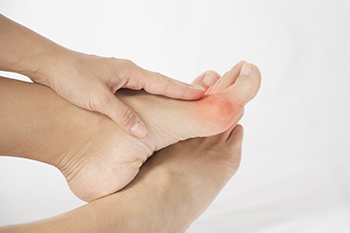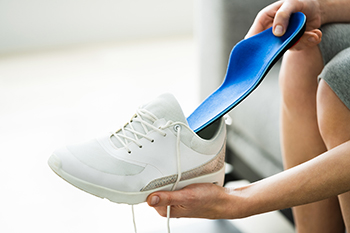Connect With Us
Blog
Items filtered by date: March 2023
Bunions Are Common

Bunions are considered to be one of the most common foot problems among adults. Research has shown that approximately one-third of adults are afflicted with bunions, and it may happen from wearing shoes that do not have sufficient room for the toes to move in freely. Additionally, genetics may play a role in developing bunions, and while that cannot be prevented, steps may be taken to bring relief. A bunion is defined as a bony growth that develops on the side of the big toe, and if the bunion is large, it may cause the other toes to shift toward each other. It is beneficial to reduce the length of time high heels are worn, and replace them with stylish shoes that have a low heel and adequate room in the toe box of the shoe. Temporary relief may be found when a protective pad is worn over the bunion, and this may be helpful in preventing corns from developing. If you have developed a bunion, it is suggested that you schedule an appointment with a podiatrist who can offer you relief, which may include surgery for permanent removal.
If you are suffering from bunion pain, contact Ronald Pieroni, DPM of Bolingbrook Foot and Ankle Center. Our doctor can provide the care you need to keep you pain-free and on your feet.
What Is a Bunion?
Bunions are painful bony bumps that usually develop on the inside of the foot at the joint of the big toe. As the deformity increases over time, it may become painful to walk and wear shoes. Women are more likely to exacerbate existing bunions since they often wear tight, narrow shoes that shift their toes together. Bunion pain can be relieved by wearing wider shoes with enough room for the toes.
Causes
- Genetics – some people inherit feet that are more prone to bunion development
- Inflammatory Conditions - rheumatoid arthritis and polio may cause bunion development
Symptoms
- Redness and inflammation
- Pain and tenderness
- Callus or corns on the bump
- Restricted motion in the big toe
In order to diagnose your bunion, your podiatrist may ask about your medical history, symptoms, and general health. Your doctor might also order an x-ray to take a closer look at your feet. Nonsurgical treatment options include orthotics, padding, icing, changes in footwear, and medication. If nonsurgical treatments don’t alleviate your bunion pain, surgery may be necessary.
If you have any questions, please feel free to contact our office located in Bolingbrook, IL . We offer the newest diagnostic and treatment technologies for all your foot care needs.
Why Live with Pain and Numbness in Your Feet?
Cracked Heels and Hot Summers

Cracked heels can result from the severe dehydration of skin on the back of the heels. If the condition is severe, the cracks can deepen and create fissures. Unfortunately, cracked heels can have an unsightly appearance. Sometimes the weather or season can affect the state of the cracked heels. For example, if it is during the summer time, the weather can be especially dry. As a result, the dry weather can exacerbate the dryness on the feet. This can worsen the state of the cracked heels. Hot summers can certainly make cracked heels worse due to the dry weather, however there are steps that you can consider taking to mitigate cracked heels. If you are someone that struggles with cracked heels, you can consider contacting a podiatrist today.
Cracked heels are unsightly and can cause further damage to your shoes and feet. If you have any concerns, contact Ronald Pieroni, DPM from Bolingbrook Foot and Ankle Center. Our doctor can provide the care you need to keep you pain-free and on your feet.
Cracked Heels
Cracked heels appear unappealing and can make it harder for you walk around in sandals. Aside from looking unpleasant, cracked heels can also tear stockings, socks, and wear out your shoes. There are several methods to help restore a cracked heel and prevent further damage.
How Do You Get Them?
Dry skin is the number one culprit in creating cracked heels. Many athletes, walkers, joggers, and even swimmers suffer from cracked heels. Age and skin oil production play a role to getting cracked heels as well.
Promote Healing
Over the counter medicines can help, especially for those that need instant relief or who suffer from chronic dry feet.
Wear Socks – Wearing socks with medicated creams helps lock in moisture.
Moisturizers – Applying both day and night will help alleviate dryness which causes cracking.
Pumice Stones – These exfoliate and remove dead skin, which allows for smoother moisturizer application and better absorption into the skin.
Change in Diet
Eating healthy with a well-balanced diet will give the skin a fresh and radiant look. Your body responds to the kinds of food you ingest. Omega-3 fatty acids and zinc supplements can also revitalize skin tissue.
Most importantly, seek professional help if unsure how to proceed in treating cracked heels. A podiatrist will help you with any questions or information needed.
If you have any questions, please feel free to contact our office located in Bolingbrook, IL . We offer the newest diagnostic and treatment technologies for all your foot care needs.
Pickleball and Plantar Fasciitis

Many people who play pickleball love to win. They may work hard at perfecting their sport and unfortunately, their feet may pay the price. The heel of the foot is commonly affected in pickleball players, which may be indicative of plantar fasciitis or a heel spur. The plantar fascia is a band of tissue that connects the heel to the toes and is found on the bottom of the foot. The plantar fascia may become torn and inflamed from consistently pushing off on the ball of the foot resulting in inflammation. Pickleball is a high-impact sport, and plantar fasciitis is often seen in pickleball players. It can be beneficial to wear shoes that fit correctly and to ensure there is adequate cushioning in the heel area. Additionally, players may choose to wear custom-made orthotics, which may be effective in reducing heel pain. If you have tried these simple measures and still have foot pain, it is suggested that you consult with a podiatrist who can determine the exact cause and offer you various prevention techniques.
Plantar fasciitis is a common foot condition that is often caused by a strain injury. If you are experiencing heel pain or symptoms of plantar fasciitis, contact Ronald Pieroni, DPM from Bolingbrook Foot and Ankle Center. Our doctor can provide the care you need to keep you pain-free and on your feet.
What Is Plantar Fasciitis?
Plantar fasciitis is one of the most common causes of heel pain. The plantar fascia is a ligament that connects your heel to the front of your foot. When this ligament becomes inflamed, plantar fasciitis is the result. If you have plantar fasciitis you will have a stabbing pain that usually occurs with your first steps in the morning. As the day progresses and you walk around more, this pain will start to disappear, but it will return after long periods of standing or sitting.
What Causes Plantar Fasciitis?
- Excessive running
- Having high arches in your feet
- Other foot issues such as flat feet
- Pregnancy (due to the sudden weight gain)
- Being on your feet very often
There are some risk factors that may make you more likely to develop plantar fasciitis compared to others. The condition most commonly affects adults between the ages of 40 and 60. It also tends to affect people who are obese because the extra pounds result in extra stress being placed on the plantar fascia.
Prevention
- Take good care of your feet – Wear shoes that have good arch support and heel cushioning.
- Maintain a healthy weight
- If you are a runner, alternate running with other sports that won’t cause heel pain
There are a variety of treatment options available for plantar fasciitis along with the pain that accompanies it. Additionally, physical therapy is a very important component in the treatment process. It is important that you meet with your podiatrist to determine which treatment option is best for you.
If you have any questions, please feel free to contact our office located in Bolingbrook, IL . We offer the newest diagnostic and treatment technologies for all your foot care needs.
Are Orthotics Right for Me?

Some people refer to orthotics as shoe inserts or foot pads. They are defined as a method to relieve foot pain, in addition to providing heel and arch support. The majority of people take thousands of steps per day, which may result in foot pain. This can make completing daily tasks difficult to accomplish, and relief is often sought. Once the source of the foot pain is identified, one of three types of orthotics may be prescribed. Pressure may be reduced while walking when soft orthotics are worn. These are designed with flexible materials, such as gel or foam. If stability is mostly needed, the choice may be rigid orthotics. They may also aid in having easier mobility. The most common type of orthotics is referred to as semi-rigid, which provides adequate cushioning and shock absorption. If you have foot pain, it is suggested that you speak with a podiatrist who can determine the cause and prescribe the type of orthotics that are right for you.
If you are having discomfort in your feet and would like to try orthotics, contact Ronald Pieroni, DPM from Bolingbrook Foot and Ankle Center. Our doctor can provide the care you need to keep you pain-free and on your feet.
What Are Orthotics?
Orthotics are inserts you can place into your shoes to help with a variety of foot problems such as flat feet or foot pain. Orthotics provide relief and comfort for minor foot and heel pain but can’t correct serious biomechanical problems in your feet.
Over-the-Counter Inserts
Orthotics come in a wide variety of over-the-counter inserts that are used to treat foot pain, heel pain, and minor problems. For example, arch supports can be inserted into your shoes to help correct overarched or flat feet, while gel insoles are often used because they provide comfort and relief from foot and heel pain by alleviating pressure.
Prescription Orthotics
If over-the-counter inserts don’t work for you or if you have a more severe foot concern, it is possible to have your podiatrist prescribe custom orthotics. These high-quality inserts are designed to treat problems such as abnormal motion, plantar fasciitis, and severe forms of heel pain. They can even be used to help patients suffering from diabetes by treating foot ulcers and painful calluses and are usually molded to your feet individually, which allows them to provide full support and comfort.
If you are experiencing minor to severe foot or heel pain, it’s recommended to speak with your podiatrist about the possibilities of using orthotics. A podiatrist can determine which type of orthotic is right for you and allow you to take the first steps towards being pain-free.
If you have any questions please contact our office located in Bolingbrook, IL . We offer the newest diagnostic and treatment technologies for all your foot and ankle needs.

